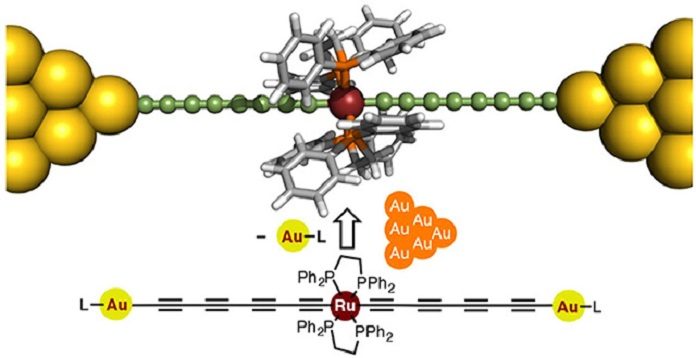Single molecule electronic devices are those in which individual molecules are utilized as active electronic components constitute a promising approach for the ultimate miniaturization and integration of electronic devices in nanotechnology through the bottom‐up strategy. Now, scientists at the Tokyo Tech have developed the new type of molecular wires doped with organometallic ruthenium to achieve unprecedentedly higher conductance than earlier molecular wires.
Since their origination, analysts have endeavored to recoil electronic devices to different sizes, even to the point of manufacturing them from a couple of molecules. Molecular wires are one of the building blocks of such tiny contraptions, and numerous scientists have been creating methodologies to orchestrate profoundly conductive, stable wires from deliberately outlined particles.
Scientists designed this new molecular-wire in the form of a metal electrode-molecule-metal electrode (MMM) junction including a polyyne, an organic chain-like molecule, “doped” with a ruthenium-based unit Ru (dope). Its design is actually based on engineering the energy levels of the conducting orbitals of the atoms of the wire, considering the characteristics of gold electrodes.
Scientists used scanning tunneling microscopy to test the conductivity of this wire. They found that the conductance of these molecular wires was equal to or higher than those of previously reported organic molecular wires.
Getting inspired by this, scientists then investigated the origin of the proposed wire’s superior conductance. They found that the observed conducting properties were essentially not quite the same as beforehand detailed comparative MMM junctions and were gotten from the orbital splitting.
In other words, orbital splitting induces changes in the original electron orbitals of the atoms to define a new “hybrid” orbital facilitating electron transfer between the metal electrodes and the wire molecules.
Yuya Tanaka from Tokyo Tech said, “Since a narrow gap between the highest (HOMO) and lowest (LUMO) occupied molecular orbitals is a crucial factor for enhancing conductance of molecular wires, the proposed synthesis protocol adopts a new technique to exploit this knowledge. The present study reveals a new strategy to realize molecular wires with an extremely narrow HOMO−LUMO gap via MMM junction formation.”
The study is published in the Journal of the American Chemical Society.
